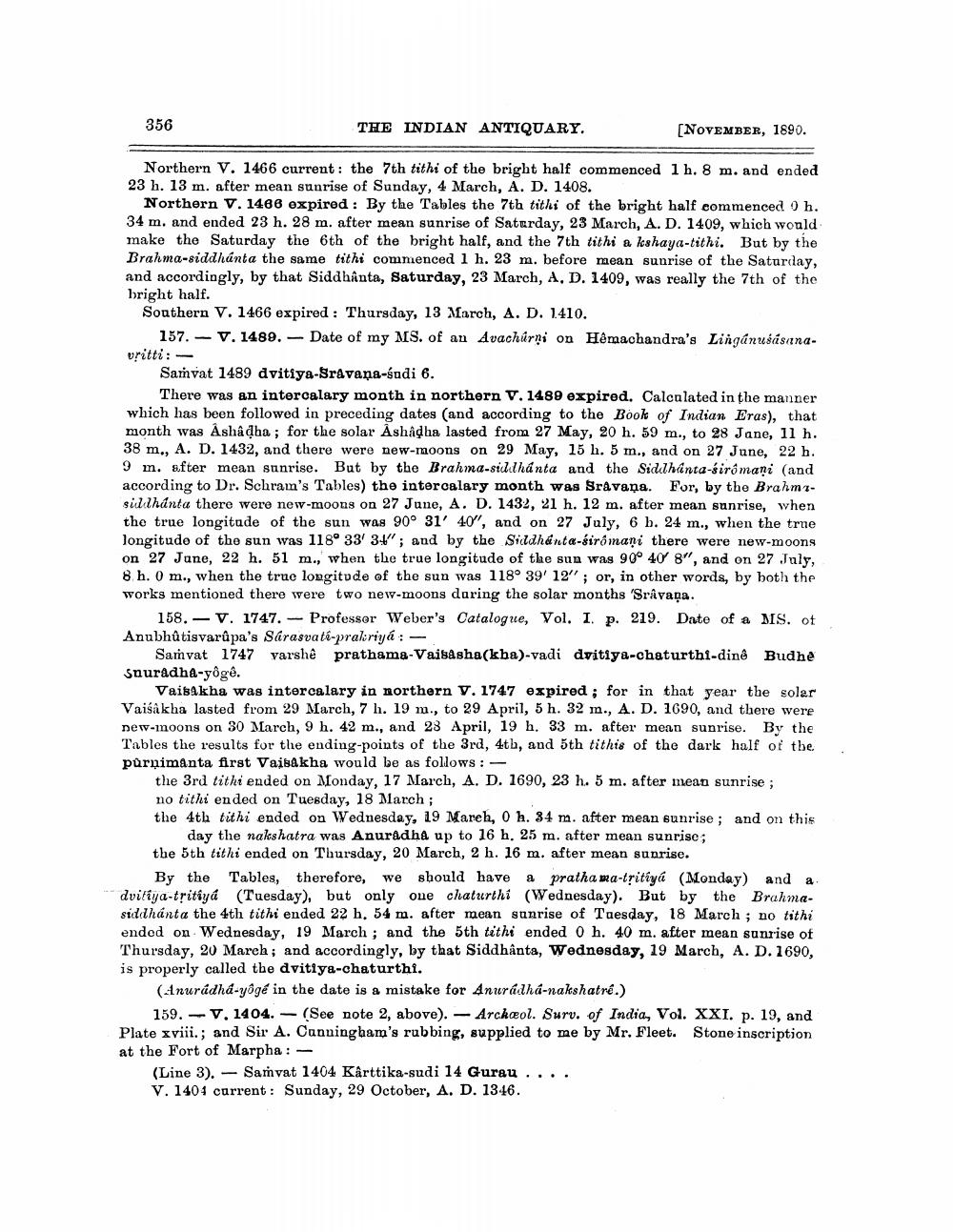________________
356
THE INDIAN ANTIQUARY.
[NOVEMBER, 1890.
Northern V. 1466 current: the 7th tithi of the bright half commenced 1 h. 8 m. and ended 23 h. 13 m. after mean sunrise of Sunday, 4 March, A. D. 1408.
Northern V. 1466 expired: By the Tables the 7th tithi of the bright half commenced Oh. 34 m. and ended 23 h. 28 m. after mean sunrise of Saturday, 23 March, A. D. 1409, which would make the Saturday the 6th of the bright half, and the 7th tithi a kshaya-tithi. But by the Brahma-siddhúnta the same tithi commenced 1 h. 23 m. before mean sunrise of the Saturday, and accordingly, by that Siddhanta, Saturday, 23 March, A, D. 1409, was really the 7th of the bright half. Southern V. 1466 expired: Thursday, 13 March, A. D. 1.410.
157. - V. 1489. - Date of my MS. of an Avachárni on Hêmachandra's Linganuálisana. vritti :
Samvat 1489 dvitiya-Sravana-sadi 6.
There was an intercalary month in northern V. 1489 expired. Calculated in the manner which has been followed in preceding dates and according to the Book of Indian Eras), that month was Asha dha; for the solar Ashâdha lasted from 27 May, 20 h. 59 m., to 28 Jane, 11 h. 38 m., A. D. 1432, and there were new-moons on 29 May, 15 h. 5 m., and on 27 June, 22 h. 9 m. after mean sunrise. But by the Brahma-sid thánta and the Siddhanta-siromani (and according to Dr. Schram's Tables) the intercalary month was Sravaņa. For, by the Brahmisiddhanta there were new-moons on 27 June, A. D. 1432, 21 h. 12 m. after mean sunrise, when the true longitude of the sun was 90° 31' 40", and on 27 July, 6 b. 24 m., when the true longitude of the sun was 118° 33' 36"; and by the Siddhanta-siromani there were new-moons on 27 Jane, 22 h. 51 m., when the true longitude of the sun was 90° 40 8", and on 27 July, 8 h. O m., when the true longitude of the sun was 118° 39' 12''; or, in other words, by both the works mentioned there were two new-moons during the solar months 'Sråvaņa.
158. - V. 1747. - Professor Weber's Catalogue, Vol. I. p. 219. Date of a MS. of Anubhûtisvarûpa's Sarasvati-prakriya: -
Samvat 1747 varshe prathama-Vaissha(kha)-vadi dvitiya-chaturthi-dinê Budhe Snuradha-yôgê.
Vaisakha was intercalary in northern V. 1747 expired; for in that year the solar Vaisakha lasted from 29 March, 7 h. 19 m., to 29 April, 5 h. 32 m., A. D. 1690, and there were new-moons on 30 March, 9 h. 42 m., and 23 April, 19 h. 33 m. after mean sunrise. By the Tables the results for the ending-points of the 3rd, 4th, and 5th tithis of the dark half of the purnimanta first Vaibakha would be as follows:
the 3rd tithi ended on Monday, 17 March, A. D. 1690, 23 h. 5 m. after mean sunrise ; no tithi ended on Tuesday, 18 March ; the 4th tithi ended on Wednesday, 19 Mareh, 0 h. 84 m. after mean sunrise ; and on this
day the nakshatra was Anuradha up to 16 h. 25 m. after mean sunrise; the 5th tithi ended on Thursday, 20 March, 2 h. 16 m. after mean sunrise.
By the Tables, therefore, we should have a pratha ma-tritiya (Monday) and a dvitiya-tritiya (Tuesday), but only one chaturthi (Wednesday). But by the Brahmasiddhanta the 4th tithi ended 22 h, 54 m. after mean sunrise of Tuesday, 18 March ; no tithi ended on Wednesday, 19 March ; and the 5th tithe ended 0 h. 40 m. after mean sunrise of Thursday, 20 Mareh; and accordingly, by that Siddhanta, Wednesday, 19 March, A. D. 1690. is properly called the dvitiya-chaturthi.
(Anuradhd-yôge in the date is a mistake for Anuradha-nakshatré.)
159. - V. 1404. - (See note 2, above). - Arckæol. Surv. of India, Vol. XXI. p. 19, and Plate xviii.; and Sir A. Canningham's rubbing, supplied to me by Mr. Fleet. Stone inscription at the Fort of Marpha:
(Line 3). - Samvat 1404 Karttika-sudi 14 Gurau .. V. 1404 current: Sunday, 29 October, A. D. 1346.




